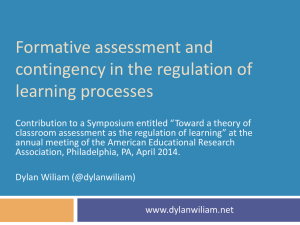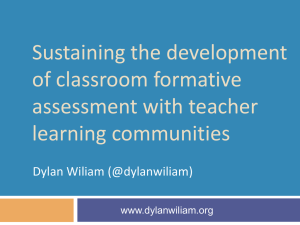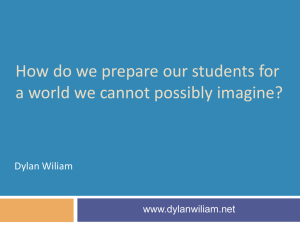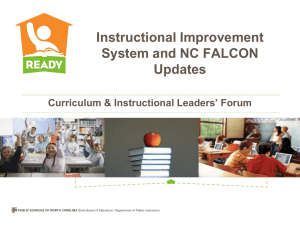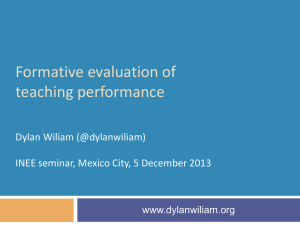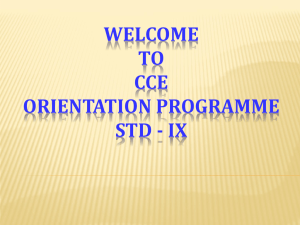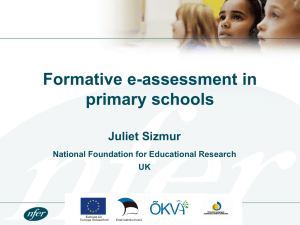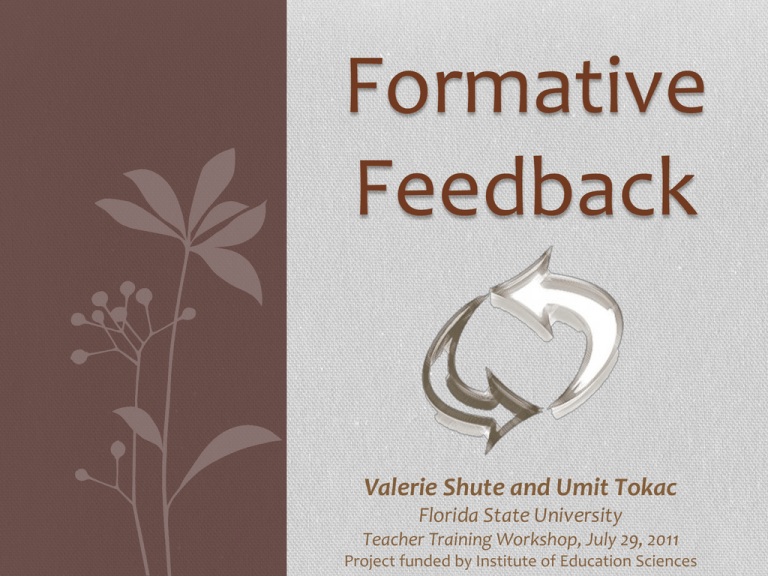
Formative
Feedback
Valerie Shute and Umit Tokac
Florida State University
Teacher Training Workshop, July 29, 2011
Project funded by Institute of Education Sciences
Acknowledgments
The work reported in this paper is supported through a grant from
Education Research Programs at the Institute of Education Sciences (IES),
award number R305A110121, administered by the U.S. Department of
Education. Faranak Rohani is the principal investigator for this research.
Related information is available at http://cala.fsu.edu/ies/. Findings and
opinions do not reflect the positions or policies of IES or the U.S.
Department of Education.
Copyright © 2011 by the Center for Advancement of Learning and
Assessment, Florida State University. All rights reserved.
Outline
General Feedback
Principles of Good Feedback
Feedback Focus
Formative Feedback
Type of Feedback
Timing of Feedback
Interactions: Student, Instruction, and Feedback
Activities
Photo by the NASA Goddard Space Center
What kind of feedback are
you using in your class?
General Feedback
Feedback is “one of the more instructionally
powerful and least understood features in
instructional design” (Cohen, 1985).
Dating back to the early 1900s, there have been
1000s of research studies published on the topic
of feedback and its relation to learning and
performance.
Within this vast body of research, there are many
conflicting findings and no consistent pattern of
results.
Benefits of Feedback
According to Black and Wiliam's (1998)
classic meta-analysis of 250 studies,
feedback positively influences learning and
achievement across all content areas,
knowledge and skill types, and levels of
education.
Principles of Good Feedback
1. Facilitates development of self-assessment (reflection) in
learning.
2. Encourages teacher and peer dialogue around learning.
3. Helps to clarify good performance (i.e., expected goals, criteria,
and standards).
4. Provides opportunities to close the gap between current and
desired performance.
5. Encourages positive motivational beliefs and self-esteem.
Juwah, C., Macfarlane-Dick, D., Matthew, B., Nicol, D., Ross, D., & Smith, B. (2004). Enhancing student learning through effective
formative feedback. York: The Higher Education Academy.
Principle 1
If students are directly involved in
assessing their own work and given
frequent opportunities to reflect on
their goals, then learning and
achievement can be enhanced
(McDonald & Boud, 2003).
Principle 2
Conceptual feedback should be a dialogue
rather than simply information transmission.
Peer dialogue is beneficial for student learning
because
• Dialogue with peers is more accessible than with teachers.
• Peer discussion provides alternative perspectives, tactics, and
strategies on problems.
• Peer discussion may be motivational.
• It is usually easier for students to accept peers’ critiques than
teachers’ critiques.
Principle 2
Teacher
or
Student
Dialogue
Student
Feedback = Dialogue. Feedback should not only
communicate information to the student(s), but also
provide opportunities to engage the teacher (or
peers) in discussion about the feedback.
Principle 3
If students don’t share their teachers’
conceptions of assessment goals, then the
feedback information they receive is
unlikely to connect (Hounsell, 1997). In
this case, it would be difficult for students
to evaluate gaps between desired and
actual performance.
Principle 4
Feedback leads to changes in student
behavior as it provides an opportunity to
close the gap in the learning process. If
the feedback provided is not quickly
turned into an action by the student, then
the opportunity to close the gap has been
missed.
Strategies for Principle 4
• Increase number of opportunities (to close the gap) for
resubmission.
• For teachers, model the strategies that might be applied
to close a performance gap in class.
• Write down some “action points” alongside the normal
feedback to identify what students should do next time
to improve their performance.
• Involve students actively in the use of feedback to
identify their own action points in class.
Principle 5
High-stakes assessment can lower students’
motivation to learn (Harlen & Crick, 2003),
thus encouraging them to focus on
performance goals (passing the test) rather
than learning goals (Elliott & Dweck, 1988).
Feedback comments without scores improve
students’ subsequent interest in learning and
performance. Again, students tend to ignore
comments when given scores.
Feedback Focus
Task-level formative feedback
• Provides specific and timely
information to the student about a
particular response to a
task/problem.
• Takes into account the student’s
current understanding and ability
level.
Feedback Focus
Features of formative feedback
• Signals a gap between current and
desired level of performance or goal
• Reduces cognitive load of a learner,
especially a novice or struggling
student
• Provides useful information that can
help correct errors
Formative Feedback
Your brain
Your brain on formative feedback
“…Information communicated to the learner
intended to modify the learner’s thinking or
behavior for the purpose of improving learning.”
Formative Feedback
Comes in a variety of types (e.g., verification
of response accuracy, explanation of correct
answer, hints, etc.).
Can be provided at various times during the
learning process (e.g., immediately after an
answer, after some delay).
May interact with other variables to
differentially affect learning (e.g., learner
characteristics, aspects of the task).
Taxonomy of Feedback Types
(arrayed by complexity)
No Feedback
“Incorrect.”
Verification
“The correct
answer is …”
Correct Response
“Incorrect. Try
again.”
Try Again
The dogs was
barking.
Error Flagging
“That’s wrong
because …”
Elaborated
Taxonomy of Feedback Types
Types of Elaborated Feedback
Attribute Isolation
Topic Contingent
Response Contingent
Hints/Prompts
Bugs/Misconceptions
Informative Tutoring
Not So Fast …
It may seem reasonable to
assume that richer, more
informative feedback—with
detailed information about
task performance—will
enhance student learning. But,
that’s not the case!
Hypothesis/Findings
Feedback that contains detailed information about
task performance will enhance student learning.
Positive Effect
No Effect
Negative Effect
Swan (1983) found
that a “bugs and
misconceptions”
approach was more
effective in enhancing
student learning
compared to simply
reteaching (topic
contingent).
Sleeman et al. (1989)
conducted 3 studies
comparing “bugs and
misconceptions” vs. topic
contingent and found (a)
they were both better
than no tutoring, but (b)
not different from each
other.
Kulhavy et al. (1985)
tested 4 types of
feedback (increasing
complexity) and found
complexity was
inversely related to (a)
ability to learn
effectively and (b)
ability to correct own
errors.
Example
Steve, which organelle is
responsible for producing
energy in a cell?
No, that’s not
right. The
correct answer is
mitochondrion.
Example
Ryan, can you list
all of the plant cell
organelles?
Let’s see …there’s the cell wall,
cell membrane, nucleus, nuclear
membrane, cytoplasm,
endoplasmic reticulum, ribosome,
mitochondrion, and vacuole.
You’re missing one organelle. Think
of an organelle that plays a big role
in the photosynthesis process.
Example
Oh, yeah.
The ribosome
is responsible
for protein
synthesis in
cells.
Example
Mary, can you tell
me which organelle
is responsible for
storing nutrients
and waste products
in cells?
Nucleus?
That is not correct.
The nucleus is
responsible for
controlling cell
activities.
Example
Ryan, can you tell me the
name of an organelle that
is unique to plant cells?
That’s
correct!!
Chloroplast is a
unique organelle
in plant cells.
Example
Kelly, can you tell me which
organelle is responsible for
producing energy in animal cells?
The Golgi apparatus is
responsible for packing
macromolecules for
transport elsewhere in the
cell. Give it another try!
Example
Steve, can you
tell me how many
different kinds of
cells you know?
That’s a common—
but incorrect—belief.
There are actually a lot
of different kinds of
cells in the world,
like bacterial and
fungal cells.
Timing
“It was my teacher's
genius, her quick sympathy,
her loving tact which made
the first years of my education
so beautiful.
It was because she seized
the right moment to impart
knowledge that made
it so pleasant and
acceptable
to me.”
—Helen Keller
Immediate & Delayed Feedback
Immediate Feedback
• Provides feedback right after a student has responded
to an item or problem.
• Prevents errors being encoded into memory.
Delayed Feedback
• Provides feedback minutes, hours, weeks, or longer
after the completion of a task or test.
• Is more appropriate to promote transfer of learning.
Example
Immediate Feedback
Kelly, do
animal cells
have cell
walls?
Yes, they
have cell
walls.
No, animal cells have cell
membranes like plant
cells, but they do not
have any cell walls.
Example
Delayed Feedback
Steve, can you
describe the function
of the Golgi apparatus
in an animal cell?
Its function is
to produce
energy.
Note that the teacher did not say whether Steve’s answer was correct or not, and
did not give any feedback on Steve’s answer. He waited to give feedback until
after he talked about the function of the lysosome and its relationship with the
Golgi apparatus in an animal cell.
Interactions
(e.g., motivation and prior knowledge)
Student
Instruction
(e.g., objectives and tasks)
Feedback
(e.g., type and timing)
Kluger and DeNisi (1996)
“To understand the world, one must not be worrying about one’s self.”—Einstein
Learning/
Performance
Goal
setting
Positive
Negative
Positive
Negative
(enhance)
(reduce)
(enhance)
(reduce)
Memory
tasks
Followingrules tasks
Nonphysical
tasks
Physical
tasks
Correct
solution
Frequent Computer
messages delivery
Personal
growth
Oral
delivery
Praise
Threats to
self-esteem No goal
setting
Discouraging
feedback
Feedback Features
Simple
tasks
Complex
tasks
Task Features
Mason and Bruning (2001)
Student
Achievement
Task
Level
Low
Lower
level
Timing of
Feedback
Prior
Knowledge
Type of
Feedback
High
Higher
level
Immediate
Low
Correct
Response
+
Response
Contingent
High
Correct
Response
+
Topic
Contingent
Lower
level
Higher
level
Immediate
Delayed
Low
Correct
Response
+
Response
Contingent
High
Low
High
Correct
Response
+
Topic
Contingent
Verification
+
Delayed
Response
+
Response
Contingent
Try Again
+
Delayed
Response
+
Topic
Contingent
Intermediate Summary
Feedback
Student
Instruction
Studies find that feedback generally improves learning
compared to control conditions but major gaps remain,
especially in relation to interactions among instructional/task
contexts and student characteristics that mediate feedback
effects.
Things to Do
Focus feedback on the task not the learner.
Provide elaborated feedback in manageable units to enhance
learning.
Be specific and clear with feedback message.
Keep feedback as simple as possible (based on learner needs
and instructional constraints).
Reduce uncertainty between performance and goals.
Give unbiased, objective feedback, written or via computer.
Promote a “learning” goal orientation via feedback.
Provide feedback after learners have attempted a solution.
Things to Avoid
Do not give normative comparisons.
Minimize use of extensive error analyses and diagnoses.
Do not present feedback that discourages the learner or
threatens self-esteem.
Use “praise” sparingly, if at all.
Try to avoid delivering feedback orally.
Do not interrupt the learner with feedback if the learner is
actively engaged.
Avoid progressive hints that always end with the correct
answer.
Do not limit the mode of feedback presentation to text.
Be cautious about providing overall grades.
Things to Avoid
Be cautious about providing overall grades.
Wiliam (2007) summarized the following findings:
1. Students receiving just grades—no learning gains
2. Those receiving just comments—large learning gains
3.Those receiving grades and comments—no learning gains
(likely due to focusing on grades and ignoring comments)
What did she do wrong?
• Ms. Lee asked a question to the class, and Amy gave the
correct answer.
• Ms. Lee said, “That’s exactly right, Amy! Your answer is much
better than the answers given by Mary and Richard. You’re
such a bright student! I’m happy to have you in my class.”
What did he do right?
• Mr. Johnson wanted Richard to list all of the plant cell
organelles.
• Richard listed most of the plant cell organelles, but he
omitted chloroplast and chlorophyll.
• Mr. Johnson let Richard know that he left out two plant cell
organelles and added that he believes if Richard thinks
about the process of photosynthesis in the plant cell, he will
be able to remember the names of the forgotten
organelles.
What did he do wrong?
• Mr. Johnson asked Byron to give the name of an
organelle that plays a role in photosynthesis.
• Byron said, “Ribosome?”
• Mr. Johnson replied, “That’s a silly answer! I can’t
believe that you still don’t know the correct answer!”
Scenario
Ms. Jackson is a science teacher. She wants to
improve her science students’ knowledge and
skills. She heard about formative feedback from
a formative feedback training workshop.
Tommy is a struggling science student with low
motivation to join in class discussions or to
answer his science teacher’s questions in class.
Scenario
Marcus is a high-ability science student who joins
in class discussions and answers his teacher’s
questions. He and Angela compete with each
other in relation to science achievement.
Angela is a high-ability science student with high
motivation to join in class discussions and
answer questions in class. She competes with
Marcus in relation to science achievement.
Jenny is a struggling science student with low
motivation to join in class discussions or to
answer her science teacher’s questions in class.
Scenario 1
Ms. Jackson just taught chemical and physical
properties of matter in her class and gave a
short quiz to her class.
Tommy and Jenny received very low scores
on the quiz.
Marcus and Angela received very high scores
on the quiz.
If you were Ms. Jackson …
What type of feedback would you use,
and when would you give it to each of
the students?
Scenario 2
Ms. Jackson is teaching an easy topic
in her class today.
She is worried about losing the
attention of her high-ability students
(Marcus and Angela) while
increasing the understanding of her
low-ability students (Tommy and
Jenny).
If you were Ms. Jackson …
What type of feedback would you use, and when would
you give it to each of the students?
How can you balance feedback for high- and low-ability
students in the class without losing the high-ability
students’ attention while increasing the low-ability
students’ motivation and understanding?
Role-Playing Activity
Teacher: Needs to teach a topic (it can be
either difficult or easy) to students today and
wants to evaluate as well as support their
understanding.
High-ability student: Has high science
achievement in the class and will evaluate the
quality of the teacher’s feedback at the end of
the activity.
Role-Playing Activity
Low-ability student: Has low science
achievement in the class and will evaluate the
quality of the teacher’s feedback at the end
of the activity.
Observer: Responsible for observing the class
and providing feedback to the teacher (at the
end of the activity) about the teacher’s use of
feedback to students.
Discussion
According to role-playing activity
Were the feedback types in the role-playing
activity used appropriately?
Was the timing of feedback appropriate?
Other comments?
Assessment Time
References
Black, P., & Wiliam, D. (1998). Assessment and classroom learning. Assessment in Education 5(1), 7–74.
Boud, D. (2000). Sustainable assessment: Rethinking assessment for the learning society. Studies in Continuing Education, 22(2), 151–167.
Butler, R. (1988). Enhancing and undermining intrinsic motivation: The effects of task -involving and ego-involving evaluation on interest and
involvement. British Journal of Educational Psychology, 58, 1–14.
Cohen, V. B. (1985). A reexamination of feedback in computer-based instruction: Implications for instructional design. Educational Technology, 25(1),
33–37.
Elliott, E., & Dweck, C. (1988). Goals: An approach to motivation and achievement. Journal of Personality and Social Psychology, 54, 5–12.
Harlen, W., & Crick, R. D. (2003). Testing and motivation for learning. Assessment in Education, 10(2), 169–207.
Hounsell, D. (1997). Contrasting conceptions of essay-writing. In F. Marton, D. Hounsell, and N. Entwistle (Eds.), The Experience of Learning.
Edinburgh: Scottish Academic Press.
Juwah, C., Macfarlane-Dick, D., Matthew, B., Nicol, D., Ross, D., & Smith, B. (2004). Enhancing student learning through effective formative feedback.
York: The Higher Education Academy.
Kluger, A. N., & DeNisi, A. (1996). The effects of feedback interventions on performance: A historical review, a meta -analysis, and a preliminary
feedback intervention theory. Psychological Bulletin, 119(2), 254–284.
Kulhavy, R. W., White, M. T., Topp, B. W., Chan, A. L., & Adams, J. (1985). Feedback complexity and corrective efficiency. Contemporary Educational
Psychology, 10(3), 285–291.
Mason, B. J., & Bruning, R. (2001). Providing feedback in computer-based instruction: What the research tells us. Center for Instructional Innovation,
University of Nebraska-Lincoln: 14. Retrieved June 1, 2006, from http://dwb.unl.edu/Edit/MB/MasonBruning.html
McDonald, B., & Boud, D. (2003). The impact of self-assessment on achievement: The effects of self-assessment training on performance in
external examinations. Assessment in Education,10(2), 209–220.
Sadler, D. R. (1989). Formative assessment and the design of instructional systems. Instructional Science, 18, 119–144.
Shute, V. J. (2008). Focus on formative feedback. Review of Educational Research, 78(1), 153–189.
Sleeman, D. H., Kelly, A. E., Martinak, R., Ward, R. D., & Moore, J. L. (1989). Studies of diagnosis and remediation with high school algebra students.
Cognitive Science, 13, 551–568.
Swan, M. B. (1983). Teaching decimal place value. A comparative study of conflict and positively -only approaches. Research Report No. 31, University of
Nottingham, Sheel Center for Mathematical Education.
Wiliam, D. (2007). Keeping learning on track: Classroom assessment and the regulation of learning. In F. K. Lester Jr. (Ed.), Second handbook of
mathematics teaching and learning (pp. 1053–1098). Greenwich, CT: Information Age Publishing.
Yorke, M. (2003). Formative assessment in higher education: Moves towards theory and the enhancement of pedagogic practice. Higher Education,
45(4), 477–501.
Questions?

